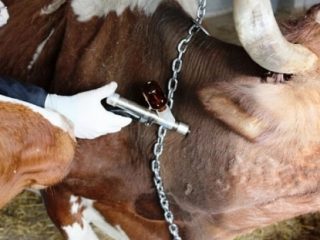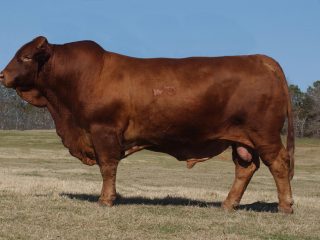Content
Cattle rabies is a dangerous disease that can be transmitted not only from animal to animal, but also to humans. Infection occurs after a bite from a sick cattle, when saliva gets on the wound, or if the meat of an animal with rabies was eaten. As practice shows, cattle are the most susceptible to rabies, which is why it is so important to carry out timely prevention and diagnosis of the disease.
Pathogenesis
In veterinary medicine, rabies is described as an infectious disease that affects the central nervous system of an animal. In an infected individual, inflammatory and necrotic processes can be observed, resulting in asphyxia or cardiac arrest.
There are 2 types of rabies in cattle, depending on the source of infection:
- natural – this includes wild animals (wolves, foxes, mice);
- urban – domestic animals, cattle.
The causative agent of this infectious disease is considered to be the Neuroryctes rabid virus, which belongs to the Rhabdoviridae family and has a bullet shape. This virus is widespread throughout the world, with the only exceptions being Antarctica and some island countries.
After the virus enters the animal’s body, it penetrates the spleen, after which it spreads along the nerve pathways. The rabies virus is stable in the external environment, as a result of which it can remain viable for several months even at low temperatures.
Clinical picture
As practice shows, rabies in cattle can occur in violent or calm form. The violent stage has the following symptoms:
- high level of irritability, manifested in sudden movements, as well as in relation to other cows and domestic animals;
- sweating;
- profuse drooling;
- frequent urination.
At a calm stage of the disease, animals begin to differ from other individuals by atypical lethargy, and their appetite disappears. Infected cows lose milk, have no ruminant reflex, and have difficulty swallowing.
It is important to take into account the fact that the symptoms described for the calm and violent forms of the disease are characteristic only of the initial stage of rabies. 2-3 days after the appearance of the first symptoms of the disease, paralysis of the lower jaw can be observed, then the limbs fail, and death occurs.
In addition, among the main symptoms of rabies are an increased reaction to extraneous noises and bright lights. These reactions are often accompanied by convulsions and weight loss. Some animals lose their vision.
Diagnostics
The diagnosis can only be made after a full comprehensive examination of the cattle has been carried out.Unfortunately, rabies in animals currently cannot be treated, so the disease is almost always fatal.
If during the diagnosis, individuals were identified that had or could have had contact with infected cows, then they are first isolated and placed in a separate room, after which a veterinary examination is carried out on a regular basis.
As a rule, high titers of the virus can be detected posthumously during examination of the cerebral cortex and medulla oblongata. Much less concentration in saliva.
When infected animals are identified, they are killed and the corpses are burned. The rest of the cattle are subject to immunization.
Prevention
The most effective way to protect cattle from rabies is the timely implementation of preventive immunization measures. Veterinarians use domestic and foreign vaccines for these purposes.
Rabies vaccines can be:
- brain – made from brain tissue taken from animals susceptible to rabies;
- embryonic – include embryos from domestic birds;
- cultural – the rabies virus is used in the manufacturing process.
Only completely healthy cattle should be vaccinated. Do not vaccinate weak individuals, exhausted, sick and cows during lactation. After the vaccination has been done, it is necessary to monitor the cow’s behavior for 3-4 days.
Vaccines against bovine rabies
For vaccination of animals, the following scheme is used;
- calves are vaccinated against rabies for the first time at the age of 6 months;
- The next vaccination is given after 2 years.
After administration of the drug, biochemical processes occur, as a result of which the susceptibility of cells to the rabies pathogen decreases. As you know, all modern vaccines are made based on a strain of the virus.
The permissible dosage is 1 ml, the drug must be administered intramuscularly. Before administering the cattle vaccine, it is necessary that the animals are first examined by a veterinarian and assessed for their general condition. It is recommended to vaccinate only completely healthy individuals.
Other methods of protection
In addition to using a vaccine, it is worth resorting to other methods of protecting cattle. First of all, the farmer must ensure cleanliness. Cleaning the premises where cattle are kept should come first. As a rule, premises are disinfected on a regular basis. In addition, it is not allowed to expose cows to contact with wild animals.
You also need:
- create safe conditions that will reduce attacks by wild animals to a minimum;
- destroy rodents;
- vaccinate dogs promptly if they are used to guard the farm;
- vaccinate healthy individuals;
- If infected individuals are identified, immediately isolate them.
This is the only way to protect your farm from the emergence of a deadly disease - rabies.
Veterinary regulations on animal rabies
Veterinary recommendations regarding animal rabies contain a set of rules for disease prevention.
According to this data, all farmers and pet owners should:
- follow the rules for keeping pets;
- deliver animals in a timely manner to a veterinary inspector for examination and vaccination;
- carry out registration of cattle owned;
- do not allow unvaccinated dogs onto the farm;
- secure the farm from wild animals;
- immediately inform the veterinarian if an infectious outbreak is detected on the farm.
These sanitary rules must be followed by everyone without exception.
Conclusion
Cattle rabies is a common type of disease that almost every farmer has had to deal with. It is possible to protect cattle from a fatal disease only if animals are vaccinated in a timely manner. Before you start using the drug, it is recommended to first consult with a veterinarian or entrust this matter to a professional.









